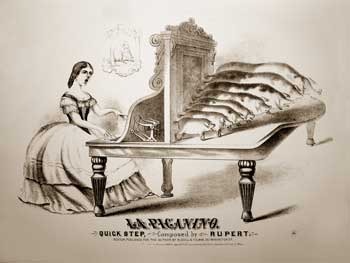Anonymous – United States, (active 1860’s)

-
La Piganino
- (1867), lithograph
- 21.4 x 32.5 in. (54.4 x 82.6 cm.)
- Private collection
-
Editor’s Note:
This is a variation of a somewhat legendary instrument also known in various forms as the Hog Harmonium, Swineway, Pigano, Pig Organ or Porko Forte.
Pierre Bayle (1647-1706) and Nathaniel Wanley (1634-1680) tell us that it was the Abbe of Beigne (or Baigne) who built a Porko Forte at the order of Louis XI, King of France (1461-83). The king challenged the Abbot, who had the art of inventing new musical instruments, to get him a “concert of swine’s voices”, thinking it impossible.
The Abbot built a keyboard device with a number of live hogs of various sizes secured beneath. And when he played upon the keys, little spikes pricked the various hogs. Presumably the hogs had been chosen for their individual consonance. Reports say the device worked well, ie: the King and his company were delighted.
There is also a similar instrument – the Cat Piano – first discussed by Athanasius Kircher (1602-1680) in his Musurgia Universalis with an imagined picture in Instruments and the Imagination, by Thomas Hankins and Robert Silverman (1995).
About the Artist
Anonymous, United States, (active 1860’s). This is the cover illustration for a piece of sheet music, “The Piganino Quickstep.” The music’s composer, as noted on the cover, is ‘Rupert’ and it was published in Boston by Russell & Richardson in 1867.
From The Lure of the Striped Pig:
“Just as understatement of the ludicrous is a standard mode of caricature, so too is overstatement, as we see in this happy example. Burlesquing genteel taste, amateur vocalists, and the vogue for Italianizing the names of all things with musical associations, this cartoon also anticipates the ingenious and surrealistic machines of Rube Goldberg. We may suppose that in more than a few parlors ‘La Piganino’ was slipped onto the music rack as a hint to the vocalist when the evening reached that point at which guests’ ears began to droop. ” (Tatham, David. 1973)

